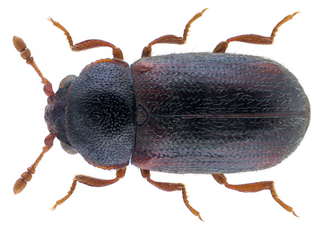
Calathus is a genus of ground beetle native to the Palearctic, the Near East and North Africa. There are at least 190 described species in Calathus.

Sphindidae is a family of beetles, in the suborder Polyphaga. They are also known as slime mold beetles due to their exclusive feeding on slime molds during adult and larval stages, other aspects of their life history are obscure. Palaeontological discoveries since 2015 have added to the geologic history of Sphindidae, including the discovery of Libanopsis, placed in the extinct subfamily Libanopsinae.

Sciodrepoides is a genus of small carrion beetles in the family Leiodidae. There are about five described species in Sciodrepoides.

Throscidae is a family of small false click beetles in the order Coleoptera. In North America, there are 3 genera and 20 described species.

Pedilus is a genus of fire-colored beetles in the family Pyrochroidae. There are at least 20 described species in Pedilus.
Anorus parvicollis is a species of soft-bodied plant beetle in the family Dascillidae. It is found in North America.
Anorus is a genus of soft-bodied plant beetles in the family Dascillidae. There are at least three described species in Anorus.
Euphrytus is a genus of leaf beetles in the subfamily Eumolpinae. There are 29 described species in Euphrytus from Central and North America, three of which are found north of Mexico.
Acmaegenius is a genus of broad-nosed weevils in the beetle family Curculionidae. There are at least two described species in Acmaegenius.
Bradyrhynchoides is a genus of broad-nosed weevils in the beetle family Curculionidae. There are at least two described species in Bradyrhynchoides.
Chrysomela crotchi, the aspen leaf beetle, is a species of leaf beetle in the family Chrysomelidae. It is found in North America.
Rhigopsis is a genus of broad-nosed weevils in the beetle family Curculionidae. There are at least two described species in Rhigopsis.
Baconia is a genus of clown beetles in the family Histeridae. There are at least 110 described species in Baconia.
Dorytomus parvicollis is a species of true weevil in the beetle family Curculionidae. It is found in North America.
Idiostethus is a genus of flower weevils in the beetle family Curculionidae. There are at least 20 described species in Idiostethus.
Rhagonycha parvicollis is a species of soldier beetle in the family Cantharidae. It is found in North America.
Pseudopentarthrum is a genus of true weevils in the beetle family Curculionidae. There are about 18 described species in Pseudopentarthrum.
Euphrytus intermedius is a species of leaf beetle. It is found in Mexico and Arizona.

Blaps is a genus of darkling beetles in the family Tenebrionidae. There are more than 30 described species in Blaps, the genus being most commonly found in Eurasia and Australia, with occasional sightings elsewhere in the world.

Eleodes parvicollis is a species of desert stink beetle in the family Tenebrionidae.






